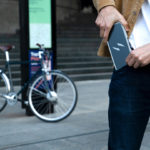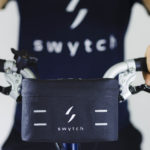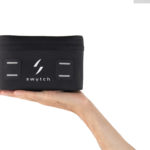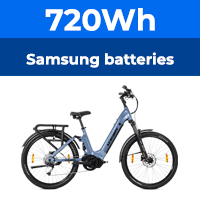Pas is very quick. When mounting it has kicked in before ones even got ones leg over ! Pretty good for a septegenarian me thinks.
Help! My next project
- Thread starter Benjahmin
- Start date
Rules start angle out then. Must be some other myserious WTF PLC setting. Carry on. I continue reading with morbid fascination and sense of dread with terminal confusion.Pas is very quick. When mounting it has kicked in before ones even got ones leg over ! Pretty good for a septegenarian me thinks.
Likely total bullocks of course: Is there a rate at which pedal assist reduces when you stop pedalling, somewhere in your WTF PLC settings? Pedal assist start/resumption might be waiting for pedal assist reduction to end?
Last edited:
Leaping sideways, like a top flight goal keeper, and plucking at this straw as it wizzes by in a gale force wind - there is some sort of regen setting in the display (instructions written in chinglish of course), however it's an AKM geared hub so there can be no regen.
Can't say I've noticed this problem, but then I tend to take advantage of gravity to freewheel down slopes! Does stopping pedalling for, say, a couple of seconds just before you reach the upslope make any difference? Just wondering if there is some sort of PAS lag caused by the higher speed? Probably not, but can't think of anything else.
Tried it both ways (careful !), when going down a main road, good surface straight bit at 35mph, one is certainly not pedalling.
Having read the C14 notes again and trying to decipher further, it seems to be referring to the relative strengths of assistance levels 1-4, with 5 still being power available at max set current......I think I'll give it a try though.
I'll give it a try though.
After all it only involves pushing a few buttons.
Having read the C14 notes again and trying to decipher further, it seems to be referring to the relative strengths of assistance levels 1-4, with 5 still being power available at max set current......I think
After all it only involves pushing a few buttons.
There are less than 25 settings on a KT controller. Angle of the dangle isn't one of them.Not knowing anything whatsoever about WTF PLC and other settings on these mysterious hub motored objects, I'm wondering if pedal assist delay has something to do with start angle? WTF WTF PLC setting that would be, I haven't the foggiest. My pedal assist start angle is a very convenient 30° - all so much easier to understand on my Bafang BBS01B mid-drive thank F. I do hope this issue is resolved somehow soon, but this thread has further put me off ever attempting a hub drive conversion.
From memory, so may be flawed. C14 at 3 adds 20% to levels 1-4. Level 5 is unchanged. C14 at 2 should be normal. C14 at 1 removes 20% at levels 1 -4. 5 is unchanged.Tried it both ways (careful !), when going down a main road, good surface straight bit at 35mph, one is certainly not pedalling.
Having read the C14 notes again and trying to decipher further, it seems to be referring to the relative strengths of assistance levels 1-4, with 5 still being power available at max set current......I thinkI'll give it a try though.
After all it only involves pushing a few buttons.
C14 at 1 doesn't work as expected on mine.
So ghost pedalling throughout the 35mph downhill makes no difference either? That ought to look the same to the controller as pedalling beyond cutout speed on the flat, and then dropping back in, which earlier you said was now smooth and immediate.
Stranger and stranger.
Stranger and stranger.
Well here's a thought experiment.
When pedalling at/around cut off speed the displayed wattage can go down to zero then will flick between that and 10-15w (almost as though there's a check going on). When speed drops power comes back in displaying 80-150ish w no matter the pas level setting. Then of course it drops out again as speed picks up.
In this scenario there is never a call for lots of power, so whether or not the power would only slowly ramp up is never demonstrated.
The situation at the bottom of a V shaped valley is different. Long descent with zero power called for. Then a sudden call for full power which is unreliably responded too.
So the conjecture is that there is an algorythm that only allows power to be ramped up to maximum slowly. Problem with this conjecture is that the response event timing is variable, i.e. it is not the same each time.
It would make sense that there is some sort of ramp so that a full 750w is not applied at the flick of a switch, as it were. But there is no knowing when this ramp up will actually begin leaving one hanging out to dry on some pretty sharp climbs.
When pedalling at/around cut off speed the displayed wattage can go down to zero then will flick between that and 10-15w (almost as though there's a check going on). When speed drops power comes back in displaying 80-150ish w no matter the pas level setting. Then of course it drops out again as speed picks up.
In this scenario there is never a call for lots of power, so whether or not the power would only slowly ramp up is never demonstrated.
The situation at the bottom of a V shaped valley is different. Long descent with zero power called for. Then a sudden call for full power which is unreliably responded too.
So the conjecture is that there is an algorythm that only allows power to be ramped up to maximum slowly. Problem with this conjecture is that the response event timing is variable, i.e. it is not the same each time.
It would make sense that there is some sort of ramp so that a full 750w is not applied at the flick of a switch, as it were. But there is no knowing when this ramp up will actually begin leaving one hanging out to dry on some pretty sharp climbs.
Another brain fart billows bigly at the blue sky: Do KT controllers field weaken? When you're barrelling downhill, the motor is a dynamo. If there's field weakening for that down then uphill scenario applied by KT firmware, perhaps it doesn't suit every motor design and voltage? Or something. Or have some factories installed different KT firmware? Brain fart expelled, feel a lot better now thanks.
I'm certainly not going to suggest anyone begin contemplating speculating about maybe investigating the possibility of trying open source firmware worm filled cans:

 endless-sphere.com
endless-sphere.com
I'm so glad I have an easily fuly programmable and easy to comprehend Bafang BBS01B mid-drive, with dirt cheap programming cable and phone/tablet/laptop/PC. Albeit a dying breed.
I'm certainly not going to suggest anyone begin contemplating speculating about maybe investigating the possibility of trying open source firmware worm filled cans:

KT motor controllers -- Flexible OpenSource firmware for BMSBattery S/Kunteng KT motor controllers (0.25kW up to 5kW)
This OpenSource firmware/embedded software runs on the BMSBattery S/Kunteng KT motor controllers. The main advantages of this controllers are: 1. sine wave/"FOC": motors run silent and very efficient 2. cheap: starting at 20€ 3. widely available: many online shops sell them and ship to worldwide...
 endless-sphere.com
endless-sphere.com
I'm so glad I have an easily fuly programmable and easy to comprehend Bafang BBS01B mid-drive, with dirt cheap programming cable and phone/tablet/laptop/PC. Albeit a dying breed.
Last edited:
Oooer. Did take a look at that thread but it had lost me by the second post.
Controllers are a black box to me.
I'll have to leave your brain fart question to those more technically educated than myself but, as far as I can see, being a geared hub the AKM can't be dynamo ing, can it?
As for programming I don't get much beyond the on button. And lets not mention chain line shall we?
Controllers are a black box to me.
I'll have to leave your brain fart question to those more technically educated than myself but, as far as I can see, being a geared hub the AKM can't be dynamo ing, can it?
As for programming I don't get much beyond the on button. And lets not mention chain line shall we?
What happens at maximum speed is normal. It's due to the back emf from the motor which causes the motor to generate the same voltage as the battery but in the opposite direction, so you get zero volts at the motor at maximum speed and nearly zero volts when you're close to maximum speed. The lack of voltage means that it can't push the current through the motor, so you can only get maximum current at low speed. In other words, the faster you go, the less voltage there is and the less current you can get. Below a certain speed, probably somewhere around 13.5 mph with a 201 rpm motor and 20A controller, depending on your battery voltage at the time, the possible current (allowed by the motor) would be above the controller limit, so the controller determines how much current you get. Above that speed, your speed determines how much current you get.Well here's a thought experiment.
When pedalling at/around cut off speed the displayed wattage can go down to zero then will flick between that and 10-15w (almost as though there's a check going on). When speed drops power comes back in displaying 80-150ish w no matter the pas level setting. Then of course it drops out again as speed picks up.
In this scenario there is never a call for lots of power, so whether or not the power would only slowly ramp up is never demonstrated.
The situation at the bottom of a V shaped valley is different. Long descent with zero power called for. Then a sudden call for full power which is unreliably responded too.
So the conjecture is that there is an algorythm that only allows power to be ramped up to maximum slowly. Problem with this conjecture is that the response event timing is variable, i.e. it is not the same each time.
It would make sense that there is some sort of ramp so that a full 750w is not applied at the flick of a switch, as it were. But there is no knowing when this ramp up will actually begin leaving one hanging out to dry on some pretty sharp climbs.
So you approach a hill at 30 mph, and the pedal assist or throttle won't kick in until you have slowed to 10 mph? Do you have a 15.5 mph speed limit set in the display?
Just been for a noodle around the village hills.
I can confirm that raising C14 to 3 does indeed raise the power level of pas settings 1-4. i.e. now pas level 1 delivers 115w instead of 80.
What I think I've now reliably observed is this:
If I coast downhill without pedalling at speeds above 15.5, then only start pedalling when speed drops to 15.5 or very near, then assist kicks in straight away. Though there is still a slow ramp up.
If I pedal downhill at speeds above 15.5 (say 25) then power only comes in unreliably some where below 15.5.
This was only a short test run, I'll go further and check this out further.
I have a 12 magnet one piece pas sensor with C1 set at 07. Depending on results I may try fitting the 10 magnet 2 piece sensor I have to see if this has an affect.
Straw desperately being clutched.
I can confirm that raising C14 to 3 does indeed raise the power level of pas settings 1-4. i.e. now pas level 1 delivers 115w instead of 80.
What I think I've now reliably observed is this:
If I coast downhill without pedalling at speeds above 15.5, then only start pedalling when speed drops to 15.5 or very near, then assist kicks in straight away. Though there is still a slow ramp up.
If I pedal downhill at speeds above 15.5 (say 25) then power only comes in unreliably some where below 15.5.
This was only a short test run, I'll go further and check this out further.
I have a 12 magnet one piece pas sensor with C1 set at 07. Depending on results I may try fitting the 10 magnet 2 piece sensor I have to see if this has an affect.
Straw desperately being clutched.
According to my tests, the controller displays the speed according to the speed sensor, but works the cut-off speed from the motor.Just been for a noodle around the village hills.
I can confirm that raising C14 to 3 does indeed raise the power level of pas settings 1-4. i.e. now pas level 1 delivers 115w instead of 80.
What I think I've now reliably observed is this:
If I coast downhill without pedalling at speeds above 15.5, then only start pedalling when speed drops to 15.5 or very near, then assist kicks in straight away. Though there is still a slow ramp up.
If I pedal downhill at speeds above 15.5 (say 25) then power only comes in unreliably some where below 15.5.
This was only a short test run, I'll go further and check this out further.
I have a 12 magnet one piece pas sensor with C1 set at 07. Depending on results I may try fitting the 10 magnet 2 piece sensor I have to see if this has an affect.
Straw desperately being clutched.
This means that the motor is always spinning without any load when you're pedalling because it gets the order from the pedal sensor. It will be frequently spinning above the cut-off speed until the cut-off stops power, then it will slow down to below cut-off, then spin up again. You won't feel anything, but you should see about 20 or 30w on the display each time it spins up.
When you freewheel, the motor is stationary, since there is no order to give it power, so no power will show on the display. Immediately you give an order for power, the motor will spin up to its max speed.
This explains what you said you're experiencing above. Also, because your motor has a low max speed, the power ramps down above 13 mph. When you say the power ramps up in scenario 1 above, it's because your speed is ramping down from above 13 mph.
In scenario 2, your motor is already spinning at 15.5 mph. No power can come until the wheel has slowed down enough for the clutch to re-engage, but then you can't get max power because you're above 13 mph.
I don't believe that you're experiencing anything abnormal. It's just the way motors work. When you go up to 48v, the effects you're experiencing will be much less, since the power ramp-down will happen at a higher speed than what you normally ride.
I have 48V and have the same characteristics. I wouldn't hold that much hope that dumping the 36V battery will solve it.According to my tests, the controller displays the speed according to the speed sensor, but works the cut-off speed from the motor.
This means that the motor is always spinning without any load when you're pedalling because it gets the order from the pedal sensor. It will be frequently spinning above the cut-off speed until the cut-off stops power, then it will slow down to below cut-off, then spin up again. You won't feel anything, but you should see about 20 or 30w on the display each time it spins up.
When you freewheel, the motor is stationary, since there is no order to give it power, so no power will show on the display. Immediately you give an order for power, the motor will spin up to its max speed.
This explains what you said you're experiencing above. Also, because your motor has a low max speed, the power ramps down above 13 mph. When you say the power ramps up in scenario 1 above, it's because your speed is ramping down from above 13 mph.
In scenario 2, your motor is already spinning at 15.5 mph. No power can come until the wheel has slowed down enough for the clutch to re-engage, but then you can't get max power because you're above 13 mph.
I don't believe that you're experiencing anything abnormal. It's just the way motors work. When you go up to 48v, the effects you're experiencing will be much less, since the power ramp-down will happen at a higher speed than what you normally ride.
I have 48v 328 rpm Q128c motor 14A and 22A KT controller and I don't get any of that. It behaves exactly like one would expect. It goes immediately when I use the throttle or pedal with whatever power I select subject to effects of back emf.I have 48V and have the same characteristics. I wouldn't hold that much hope that dumping the 36V battery will solve it.
Thanks Saneagle. I'm not sure I fully understand but it seems then that the system is working as it should. If this is so then it is hugely disappointing as it makes it impractable for the many V shaped bottoms with steep climbs out that I encounter. I'm not looking for great speed here but 60-80 watts very slowly ramping up on a 1:8 or greater climb is, frankly, bloody useless.
I don't understand why you reference 13mph.
The Ezee was fully there straight away, this is what I'm used to. This, of course, was speed control and I'm wondering if changing this system to speed control would help this issue.
I only started this project as the Ezee was an unmarked big motor that didn't cut off at 15.5mph. I was just trying to be legal. Hurumph !
I don't understand why you reference 13mph.
The Ezee was fully there straight away, this is what I'm used to. This, of course, was speed control and I'm wondering if changing this system to speed control would help this issue.
I only started this project as the Ezee was an unmarked big motor that didn't cut off at 15.5mph. I was just trying to be legal. Hurumph !
Related Articles
-
 Swytch announce new conversion kit with ‘pocket-sized’ battery
Swytch announce new conversion kit with ‘pocket-sized’ battery- Started by: Pedelecs
-
 New Swytch launches on Indiegogo, raises £100k in first hour
New Swytch launches on Indiegogo, raises £100k in first hour- Started by: Pedelecs
-
 Swytch to unveil 70% smaller, 50% lighter conversion kit
Swytch to unveil 70% smaller, 50% lighter conversion kit- Started by: Pedelecs


